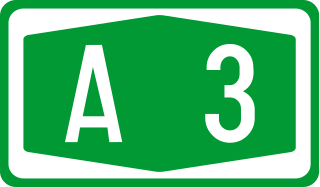Novo Selo may refer to the following places:
Ante Radonić is a Croatian astronomer and popularizer of astronomy, who writes for the weekly radio show Andromeda.
The subdivisions of Croatia on the first level are the 20 counties and one city-county.

The A3 motorway is a major motorway in Croatia spanning 306.5 kilometres (190.5 mi). The motorway connects Zagreb, the nation's capital, to the historical Slavonia region of Croatia and a number of cities along the Sava River. It represents a major east–west transportation corridor in Croatia and a significant part of the Pan-European Corridor X, serving as a transit route between the European Union states and the Balkans. Apart from Zagreb, where the A3 motorway comprises a considerable part of the Zagreb bypass, the motorway runs near a number of significant Croatian cities.

The Battle of the Barracks was a series of engagements that occurred in mid-to-late 1991 between the Croatian National Guard and the Croatian police on one side and the Yugoslav People's Army (JNA) on the other. The battle took place around numerous JNA posts in Croatia, starting when Croatian forces blockaded the JNA barracks, weapons storage depots and other facilities. It formally began on 14 September; its objective was to neutralise the JNA positions in ZNG-held territory and to secure arms and ammunition supplies for the poorly equipped ZNG.

Matica hrvatska is the oldest independent, non-profit and non-governmental Croatian national institution. It was founded on February 2, 1842 by the Croatian Count Janko Drašković and other prominent members of the Illyrian movement during the Croatian National Revival (1835–1874). Its main goals are to promote Croatian national and cultural identity in the fields of art, science, spiritual creativity, economy and public life as well as to care for social development of Croatia.
Konzum is Croatia's largest supermarket chain, with over 700 stores throughout the country and more than 10,000 employees. Konzum serves over 650,000 customers each day. With its headquarters in Zagreb, Konzum is part of the Fortenova Group since 1 April 2019.
The Croatian Parliament electoral districts are the special territorial subdivision of Croatia used for the country's parliamentary elections.

Croatia osiguranje d.d. is an insurance company based in Zagreb.

Telephone numbers in Yugoslavia consisted of a 3-digit area code followed by 6 digits. In Serbia, they mainly began with 1, 2 or 3, in Croatia 4 or 5, in Slovenia 6, Bosnia and Herzegovina 7, in Montenegro 8 and in North Macedonia 9.

State Attorney's Office of the Republic of Croatia is an autonomous and independent judicial body empowered and duty-bound to instigate prosecution of perpetrators of criminal and other penal offences, to initiate legal measures to protect the property of the Republic of Croatia and to apply legal remedies to protect the Croatian Constitution and laws.
The Treća nogometna liga, commonly Treća NL or 3. NL, is the fourth tier of the Croatian football league system. The league was reestablished in 2022 following the reconstruction of league system in Croatia. It is operated by the Croatian Football Federation.

The First Croatian Savings Bank was a significant Croatian bank headquartered in Zagreb. The bank was founded in 1846 and liquidated in 1945.